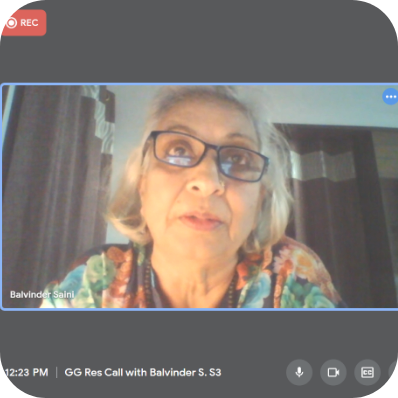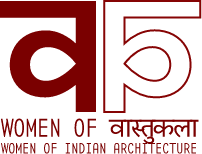
Balvinder Saini
Balvinder Saini is an architect from Chandigarh. She has extensively worked on government projects in Haryana and Chandigarh. Along with architecture and planning, she was also a part of documenting the archives and heritage of Chandigarh.
INTERVIEWEES
Formative years, marriage and becoming Chief Architect
Summary:Luckily, with the support of her parents and her husband, she continued to work till she retired as Chief Architect in 2012, putting in 31 years of service. She explains the hierarchy in her department and the roles involved across structures. She also notes the various advantages the government role provided her including how it offered her projects of varying magnitude. In a specific incident, she recalls how for a time-bound project commissioned by the Chief Minister, they were given only two days to provide a new concept. After having visited many sites across the width of Punjab on a hectic schedule, she reached her team’s location the final night and made the presentation the next morning. She remembers how they celebrated their positive results and how she distinctly misses such career moments. In connection to a slum rehabilitation project, she pursued a postgraduate diploma in land management and formal settlement regularisation in 2011. She had also participated in an archival project since. In her retirement years, she refrains from active practice and only participates as a subject expert in colleges. She much rather prefers to catch up on her reading and travelling.
Balvinder Saini
Balvinder Saini
Ishita Shah
00:29:56
Online
22/11/2021
English
(00:06:10) My sister’s husband was a practising architect, (00:22:50) Produced a concept for Model Jail in 2 days as part of a strict time-bound project, (00:24:53) Working on-site alone as a woman practitioner, (00:25:41) PG Diploma on Land Management and Formal Settlement Regularisation at Rotterdam in 2011, (00:27:14) Retired in the year 2012
Early influences, childhood, and Chandigarh city
Summary:When the family moved to Chandigarh, she notes how the green city grew on her. She loved visiting the avenues, and the lake and felt at peace with the place. Until the age of 11, she grew up in many places due to her father’s frequent work postings as a civil services employee. She notes how it was rather the environment and not the buildings that she could relate to as a child. She and her family grew up with necessary possessions only, and she played with the dolls that her sister used to make for them, which she still treasures. She would assist in the crafts activities at home with self-sourced resources. This habit has stuck to her till this day as she loves making architectural models. She also recalls how she would go on rides with her brother-in-law to various places as she was interested in travelling and sketching anything available to her.
Balvinder Saini
Balvinder Saini
Ishita Shah
00.33.33
Online
22/11/2021
English
(00:00:56) My experiences of having witnessed the making of Chandigarh city, (00:09:26) Early impressions of architecture studies and profession, (00:12:20) “Chandigarh as a city, it grew on me.”, (00:17:00) Courtyard as a significantly interesting design space
Architecture education, college projects & involvement in college
Summary:Speaking of the women in her architecture classes, she recalls how they were always known to be sincere and hardworking. On their involvement in her department, she notes how she was only the second woman ever to become Chief Architect. She talks of the unfair view in which the women employees were held, as they were never involved on-site. It was only when she took the initiative to work on-site herself that she was allowed to participate more on that aspect, which invariably added to the awkward (if few) interactions with her seniors. Talking about her college campus, she shares fond memories of how she loved the courtyard, canteen, and studio due to its environment and less because of its space. She notes how its human-scale size and good detailing added more value to it. She goes on to realise how the space has transformed since then, and expanded on her fondest project interactions.
Balvinder Saini
Balvinder Saini
Ishita Shah
00:20:42
Online
22/11/2021
English
(00:04:54) Housing in hill stations project and approach towards it, (00:06:40) Discrepancies in teaching habits of Indian vs international teachers experienced during my PG diploma studies, (00:10:05) The girls vs boys scenario in college classes, (00:12:17) “Not used to having girls at offices.”
Early career, deputation, notable projects and work process
Summary:Expanding on the many lived experiences in her work and design, she points to specific examples. She goes into depth about the basic workflow, ethics, and approach, including the many collaborations (including with architect Renu Saigal), and insights she and her team adopted in working through the projects. In explaining how she approached a project, she also brings attention to how the bureaucracy system affected her work, with specific instances from her experiences. Specifically taking into account the projects initiated in the Chandigarh administration, , she describes the process, design thought, functionality, and material choices she made and why.. In acknowledging the changes that needed to be brought into the system – she details how she negotiated those changes with stakeholders in particular connection to the judicial complex and college projects.
Balvinder Saini
Balvinder Saini
Ishita Shah
00:48:39
Online
24/11/2021
English
(00:01:28) What does deputation mean?, (00:15:00) Prakash Singh Badal’s agenda for progress, (00:20:30) Working with a woman practitioner , (00:36:53) Octagonal classrooms and experiments while designing college spaces etc.
Collaborations, post graduation, institutions & recognition
Summary:Moving on to the documentation work she undertook at the office in Chandigarh, she talks about the preservation efforts of archiving the original drawings and documents. She talks about interesting works she came across including sketches of Corbusier. Apart from being Chief Architect, she talks about other roles she occupied including being part of the Sexual Harassment Committee at the office. At the national level, she engaged in several conferences as part of departmental activities. Moving on to her post graduation, she lays out the story behind her selection at the time she was a senior architect after repeatedly applying. Moreover, she explains her journey in participating toward a fellowship in land management and informal settlement regularisation in 2011 at the Erasmus University, Rotterdam.
Moving on to her relationship and interaction with the Council of Architecture (COA), she expands on the time she spent being in the committee as a member from 2009 – 2010, while explaining her role and how the interactions evolved. On the recognition her projects received and how they were viewed in the media, she mentions the acclaim and awards she received and her impressions of them. She talks about how the department working on the media covers the projects they worked on. On documentation efforts, she talks about the only time an exhibition was held at the Chandigarh Administration when works were organised for public view. Concluding on the associations and collaborations, she explains the extent to which consultants and specialists were called on for external support on projects with the Administration.
Balvinder Saini
Balvinder Saini
Ishita Shah
00:40:43
Online
24/11/2021
English
(00:03:05) Discussions on village sanitation systems and introducing change, (00:05:07) Shamlat land - shared land by the people, (00:16:00) Being approached for a postgraduate course out of the blue , (00:30:40) Exhibition of Department’s work
Notable projects, decision-making process & design approach
Summary:Balvinder Saini
Balvinder Saini
Ishita Shah
00:32:16
Online
29/11/2021
English
(00:01:31) Working on an entire project by myself, (00:07:30) The Commemorative Cubes’ project, (00:22:00) Challenges of designing public institutions’ infrastructure
Professional journey, senior architects, technology & observations
Summary:Talking about the many special projects she took up, she goes into detail about the competition, concept, and engagements involved. On adapting to the technological advancements, she remembers her first interactions with working with computers at the Punjab Administration. She lists how the efficiency of standardisation across time-bound government projects proved itself, and in the case of whether it was a standardisation of detail or of form/experience of spaces. Moreover, while drawing from her observations as a child in the spaces she had lived and experienced,she details the alterations she has made to standard designs. She talks further about the details that make her projects more universally accessible. In conclusion, she speaks of how integral the by-laws are with government buildings, her approach to conservation, and the coordinated efforts of the sanctioning and making department.
Balvinder Saini
Balvinder Saini
Ishita Shah
00:39:51
Online
29/11/2021
English
(00:00:55) The meticulous detailing of Eulie Chowdhury’s designs and work, (00:14:45) Guiding and mentoring new women recruits in office, (00:21:10) Getting introduced to computers and digital technologies, (00:32:05) Approach towards a barrier-free environment and increase accessibility in designs
Work-life balance, women architects and conservation efforts
Summary:Going back to the significance of the much-awaited UNESCO world heritage status for the Capitol Complex designed by the architect Le Corbusier, she details negotiating preservation with indifferent stakeholders prior to receiving its status. Extending on her experience with conservation efforts, she points to the frugality of regional committees for policy-making. In the face of recent architectural developments, she extends her observations on the scenario in Punjab, and Haryana and their impact on Chandigarh. She believes that in times of exceeding consumerism, vernacular or traditional architects should be especially encouraged. Concluding on her involvements with educational institutions, consultancies, she recounts experiences with the architecture students from her alma mater, CCA. She closes with her observations of the COVID-19 pandemic years and her perception of receiving recognition as a woman architect.
Balvinder Saini
Balvinder Saini
Ishita Shah
00:48:33
Online
29/11/2021
English
(00:01:09) Being a mother and architect , (00:05:45) When my son told me about feeling proud that his mother is an architect, (00:09:30) Working as a woman in office spaces, (00:27:40) Response to the growth and planning of Chandigarh city, (00:37:30) Insights into current education pedagogy and the students at CCA
